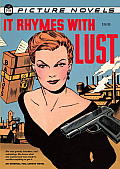Dark Horse Stumbles?
There’s only one reason that Dark House Books reprinted It Rhymes with Lust, script credited to Drake Waller and art to Matt Baker and Ray Osrin: it’s one of the first American attempts to publish a novel-length story in comics form. In other words, it’s a candidate for being the earliest graphic novel.
But you couldn’t tell that from the reprint. Nowhere on or inside the book is the date of its original publication in 1950; instead, the date on the copyright page in 2007, when Arnold Drake wrote the afterword. Nowhere does the book state that its author is a pseudonym for Drake and Leslie Waller. Indeed, Drake’s afterword doesn’t even make clear that what it calls “that first story” is the same volume one is holding.
Nowhere on or inside the book is a statement—even a single sell line—about the book’s significance in comics history. Instead, Dark Horse has carefully recreated the front and back covers of the original, with all the breathless, melodramatic text. In combination with a 2007 copyright date, the result looks like a parody or a nostalgic attempt to recreate comic noir.
Given that the market for stories about family dysfunction and corruption in post-WW2 mining towns is probably small, I think Dark Horse missed a bet in how they packaged this book. They found space on the copyright page for a list of publishing personnel (something one rarely sees from mainstream American publishers), yet nowhere said, “This book is a piece of comics history, and here’s why…”
I guess the company thought its target readers would find the book in comics shops and recognize its significance from Wikipedia. And some people might say those assumptions reflect a larger problem with the American comics industry.
But you couldn’t tell that from the reprint. Nowhere on or inside the book is the date of its original publication in 1950; instead, the date on the copyright page in 2007, when Arnold Drake wrote the afterword. Nowhere does the book state that its author is a pseudonym for Drake and Leslie Waller. Indeed, Drake’s afterword doesn’t even make clear that what it calls “that first story” is the same volume one is holding.
Nowhere on or inside the book is a statement—even a single sell line—about the book’s significance in comics history. Instead, Dark Horse has carefully recreated the front and back covers of the original, with all the breathless, melodramatic text. In combination with a 2007 copyright date, the result looks like a parody or a nostalgic attempt to recreate comic noir.
Given that the market for stories about family dysfunction and corruption in post-WW2 mining towns is probably small, I think Dark Horse missed a bet in how they packaged this book. They found space on the copyright page for a list of publishing personnel (something one rarely sees from mainstream American publishers), yet nowhere said, “This book is a piece of comics history, and here’s why…”
I guess the company thought its target readers would find the book in comics shops and recognize its significance from Wikipedia. And some people might say those assumptions reflect a larger problem with the American comics industry.



No comments:
Post a Comment